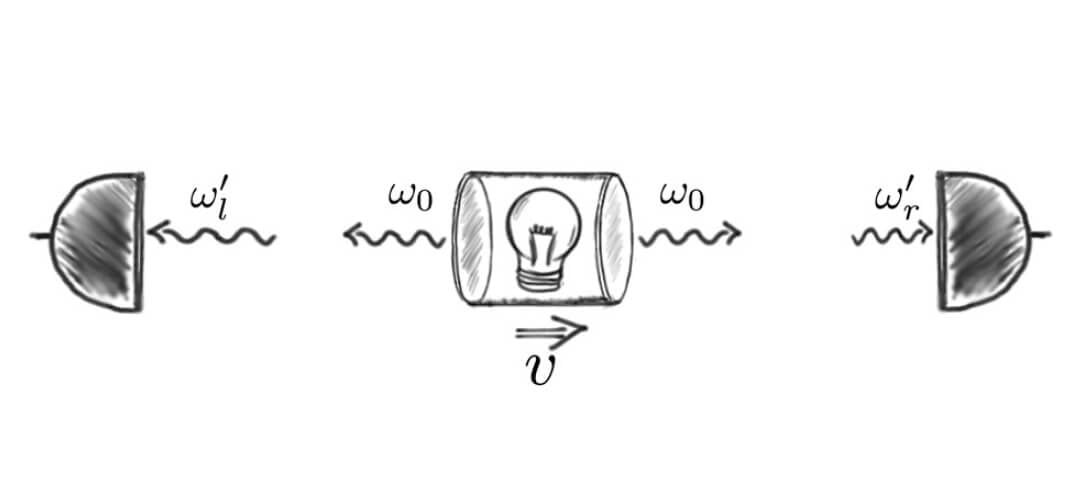- Get link
- X
- Other Apps

One of the fundamental postulates of modern physics is that in a medium of an ideal vacuum - a space that does not contain any matter - there can not be such a process as friction, because a completely empty space can not act on this force on objects passing through it.
Despite this generally accepted opinion, physicists from the UK have determined that a decaying atom passing through a full vacuum medium will experience the effect of a frictional force. Moreover, scientists were able to find out that this phenomenon rather reinforces, rather than disproves, the general theory of relativity of Einstein.
"We spent a lot of time looking for possible errors in the calculations, and even more, studying other strange inconsistencies, have not yet found, as it turned out, a fairly obvious solution," Matthias Sonnleitner of the University of Glasgow told Phys.org.
When carrying out calculations to predict the behavior of a decaying atom moving through an ideal vacuum, Sonnleitner and his colleagues discovered something strange. Physicists have long known that an ideal vacuum can not apply any forces to atoms, but still is able to interact with them in a special way.
To date, scientists are not able to create the conditions of an ideal vacuum, because no level of checks is able to ensure the purity of the experiment, creating confidence that some atom will not leak into this space. However, the calculations predict that the theoretical ideal vacuum will in fact be filled with its own special energy, as well as "virtual" pairs of antiparticle particles that have the ability to suddenly appear and just as suddenly disappear.
This description of the ideal "empty, but not empty" vacuum follows from the aspect of quantum mechanics, called the Heisenberg uncertainty principle, which speaks of countless theoretical virtual particles appearing and disappearing in a vacuum at a random time. These quantum shifts create random fluctuating electric fields, and the team's calculations from Glasgow describe how these fields can interact with atoms moving at that moment through the vacuum space, absorbing energy and passing into an excited state.
As an atom in a state of excitation decays to a lower energy state, it will be able to radiate a photon (a particle of light) in a random direction. The researchers calculated that when a moving atom emits a photon in the opposite direction of its movement, at that moment a frictional force will be created, which will be displayed as a decrease in the speed of movement of this atom. If this is actually the case in practice, then this will contradict the principle of relativity, since in this case it will be understood that the "observer", depending on where he is relative to this atom, will have to see an atom moving at different speeds.
Sonnleitner says that his team "spent weeks trying to find the right answer", and the solution was reduced to an unexpectedly simple formula E = mc 2 . The scientists realized that the decaying atom at the time of its movement and the emission of a photon in a random direction will lose a small amount of energy, as well as mass. This quantity of mass is called the defect of mass, and this value is so insignificant that it has never been measured in such a context before.
"This is the same mass in Einstein's famous equation E = mc 2 , which describes the amount of energy needed to separate the nucleus of an atom into its constituent protons and neutrons. It is also called the binding energy of the nucleus. The term is widely used in nuclear physics, which deals with large binding energies, but, as a rule, is considered insignificant in atomic optics, since it operates with very small energy values. ”
When the researchers substituted the value of the mass defect into their calculations and used the formula E = mc 2 for the solution, they found that with the loss of an insignificant mass value during decay, the atom actually loses momentum, not speed.
In the relationship between friction, momentum, and speed, where friction would be considered as the result of a change in momentum due to a loss of speed, scientists consider the loss of momentum as a result of a change in the mass of an atom. Its speed remains constant, as it should. Thus, the presence of friction in a vacuum does not violate the theory of relativity. In fact, this behavior is predicted in the special theory of relativity, where it is said that the loss of mass can cause a subtle loss of momentum.
“By our calculations, we have shown that a decaying atom really collides with a force resembling friction. However, this force is represented as a change in momentum due to a change in the internal value of the mass and energy of the atom, and it is not at all connected with its slowing down. ”
Now researchers want to check whether this phenomenon will manifest itself if the atom absorbs, rather than emits, a photon. And it is possible that this information can be used to explain the results of another study, which also hinted at the presence of friction in an ideal vacuum. In 2011, physicists have suggested that the vacuum can indeed have friction if a large amount of “virtual” particles in it move in the opposite direction to the physical object in it.
It was not yet possible to prove this in real conditions, but one thing is for certain already now: strange things sometimes happen in complete emptiness.
The article is based on materials .
- Get link
- X
- Other Apps
Comments
Post a Comment